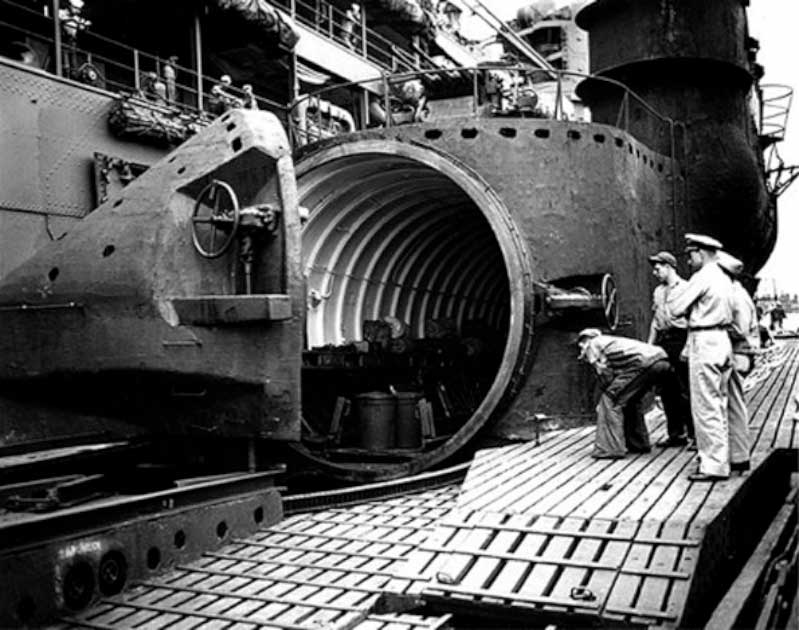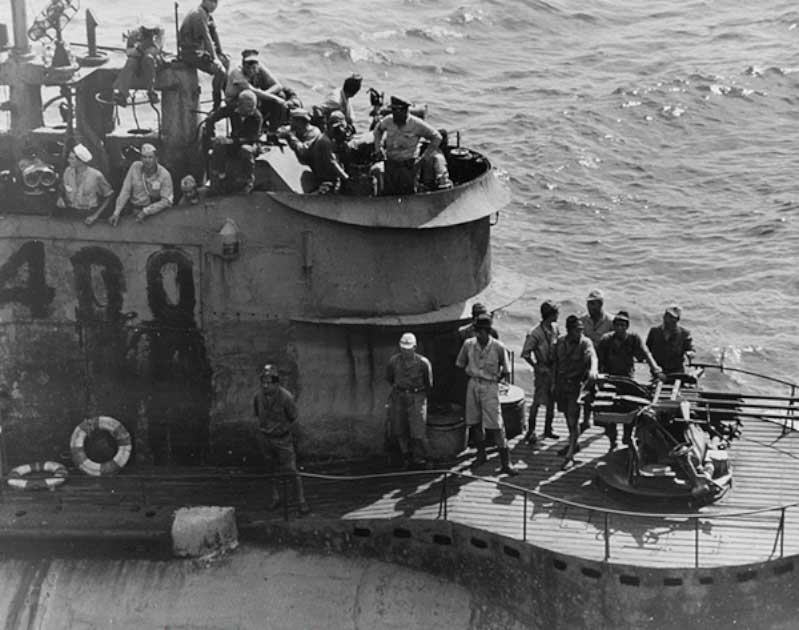The two greatest conflicts the world has ever known occurred in the last century. World War I and World War II saw the greatest concentrated loss of life, the greatest destruction and the greatest involvement of manpower and material of any conflict in human history.
The World Wars also led to ingenuity and brilliance in solving the problems of battlefield victory, and this need for quick, unexpected solutions led to the creation of some truly strange weapons of war. Take for example, the problems being faced by Japan.
The United States and Japan were caught in a stalemate where neither one was able to strike a hammer blow and defeat the other. The Japanese, facing a war of attrition they knew they could not win, needed something never before seen. They needed to be able to surprise the Americans on their own territory.
The Japanese I-400
The solution was truly innovative. The Japanese I-400, the largest submarine ever built in World War II, would approach the United States mainland undetected. Once in position, it would surface and launch attack aircraft to destroy valuable targets on land. Its mission done, the submarine would slip away, leaving the Americans baffled as to how the attack had taken place.
The Japanese I-400 was designed and commissioned by the Imperial Japanese Navy, and named Sen-Toku-gata Sensuikan, or “Submarine Special”. These underwater aircraft carriers were designed alongside special floatplanes which were launched from a catapult on the front of the submarine.
- Enormous, Secret and French: What Happened to the Surcouf?
- Did Germany’s Amerika Bomber Ju 390 Secretly Fly to U.S.?
Once the mission was completed the planes would rendezvous with the submarine, landing on the water on their skid floats. They would then be recovered by a crane, or if necessary deliberately sunk once their crews were back on board.
An Ambitious Plan
The initial plan was to create and launch 18 such submarines that could make a round trip to the west coast of the USA from almost any Japanese base in the Pacific. However, after problems emerged with the design of the submarine the project was scaled down. Of the 18 submarines, only three were built and only two were commissioned into active service. The third one was completed but never made it to the sea as the war was over by the time it had been finished.

On August 28, 1945, two United States destroyers intercepted a large, unknown Japanese submarine that was larger than any they had previously encountered. The gigantic vessel surrendered to the US ships without any incident.
A day later, another US submarine crossed paths with a similar Japanese submarine, and this one surrendered after a brief, futile chase. This was the first the Americans knew about the submarine: secrecy had been absolute and the United States would have truly been caught by surprise.
When the American naval vessels first discovered the two submarines, the crew inside the aircraft carriers thought that the large space inside was meant to carry a lot of wartime cargo. Later, they came to know that it was a hangar out of which attack planes could be launched. The massive underwater aircraft carriers, 400 feet (121 m) long and 39 feet (12 m) wide, were unlike anything ever seen before.
The Design of the I-400
The aircraft carriers were a design marvel when they were first commissioned. The huge submarine had four engines and could carry enough fuel to travel around the world one and half times. This would have helped the submarines reach the US from both the Atlantic and Pacific coasts.
Each such submarine was capable of storing around three full-scale fighter aircrafts ready to launch missiles on US cities. Although the I-400 was a design advancement ahead of its time, design flaws and compromises made the submarine slow too. For example, it was challenging to maintain control over the submarine when it surfaced because it had such small rudders.
- Project Azorian: Did Howard Hughes Try to Steal a Russian Sub?
- The Largest Aircraft in WW2: What happened to the “Gigant”?
The superstructure was also immense, and the sub would often veer off course if there were strong winds. Moreover, the safe diving depth of the I-400-class submarine was only 82 per cent of its total length: it could barely hide underwater. Therefore, the underwater aircraft carrier could not dive deep with speed and at a steep angle in case of emergencies.
In a way, these drawbacks defeated the purpose of the I-400-class submarine, as the submarines could not use stealth at the right time. The large framework of the I-400 meant it was way too visible to stay undetected. The large carriers could be easily detected by the enemy and could be easily targeted. Stealth and speed in reality was simply not possible.
The dive time of these large submarines was 56 seconds, almost a minute. The time was longer than their United States counterparts, and this gave the enemy enough time to take these submarines out. The speed and efficiency of the entire submarine were also highly reduced due to its design drawbacks.

Apart from these drawbacks, the I-400 could not be well fitted to support the crew of the submarine and the floatplanes. The crew had to sleep in the passageways and decks. There were no air conditioning systems and no flushing toilets.
Brilliant Idea, Flawed Execution
The lack of resources, design flaws, and the timing of their commission, all made the I-400 project a failure for the Imperial Japanese Navy. The concept was brilliant, but the technology available and the limitations these imposed on the design meant she would never deliver the knockout blow the Japanese were hoping for.
Perhaps, some day in the future these limitations will be overcome. Until then the I-400 remains a one-off concept, a curio of the Second World War.
Top Image: Truly bizarre: the I-400, a Japanese Underwater Aircraft Carrier. Source: US Navy / Public Domain.
By Bipin Dimri